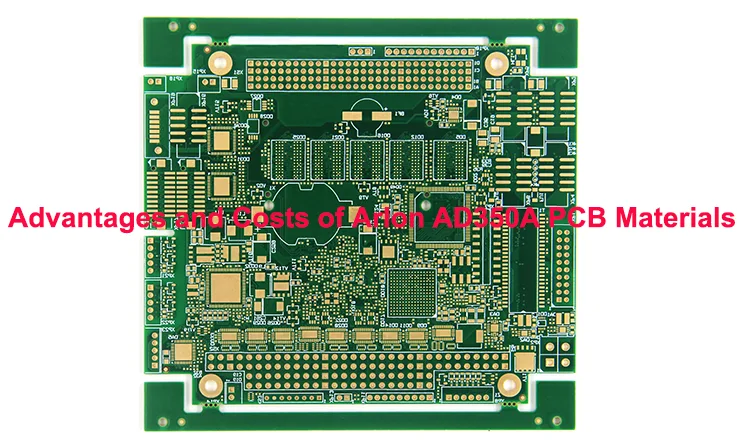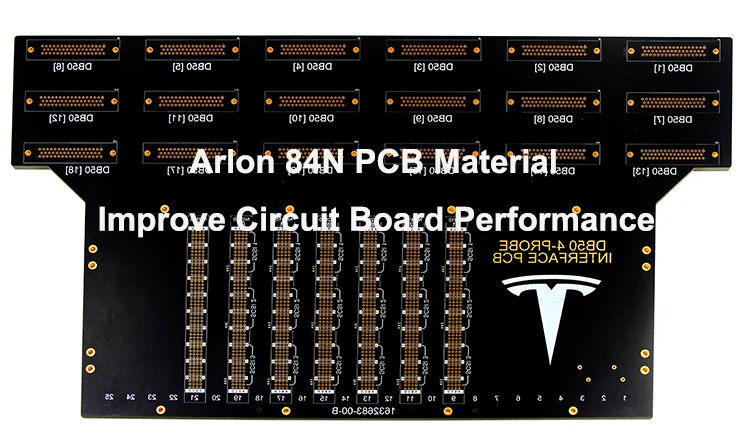
In the world of printed circuit boards (PCBs), the choice of materials is crucial for achieving optimal performance and reliability. One such material that has gained attention is Arlon AD350A. With its advanced properties and superior performance, Arlon AD350A has emerged as a compelling option for high-frequency and high-speed applications. However, these advantages come at a higher cost compared to the standard FR4 material. This article explores the reasons behind the increased expense of using Arlon AD350A for PCB manufacturing and highlights the benefits it offers.
What Is Arlon AD350A PCB Materials?
Arlon AD350A is a type of PCB (Printed Circuit Board) material manufactured by Arlon Electronic Materials. It is a high-performance thermoset woven glass-reinforced epoxy laminate with a ceramic filler. The AD350A material is designed to provide excellent electrical properties, thermal stability, and mechanical strength for demanding electronic applications.
Features of Arlon AD350A
The features of Arlon AD350A PCB material include:
1. Well-Controlled Dielectric Constant: Arlon AD350A has a dielectric constant (Dk) of 3.50 with a tight tolerance of +/- 0.05. This ensures consistent electrical performance and helps maintain signal integrity in high-frequency applications.
2. Low Insertion Loss Tangent: The material has a low insertion loss tangent of 0.003 at 10 GHz. This low loss tangent indicates minimal signal attenuation and helps preserve the quality of high-frequency signals.
3. Low Z-Axis Thermal Expansion: AD350A exhibits a low Z-axis thermal expansion of 35 parts per million per degree Celsius (ppm/°C). This characteristic is important for applications that experience significant temperature variations, as it helps minimize the risk of stress-induced failures or dimensional changes in the PCB.
4. Larger Panel Sizes Available: Arlon AD350A is available in larger panel sizes, which can be beneficial for applications that require larger PCBs or higher production volumes. Larger panel sizes can help improve manufacturing efficiency and reduce costs by allowing more circuits to be produced in a single manufacturing run.
These features make Arlon AD350A suitable for high-frequency and high-reliability applications, such as microwave communication systems, RF (Radio Frequency) devices, and high-speed digital circuits. The material’s controlled dielectric constant, low insertion loss tangent, low thermal expansion, and availability in larger panel sizes contribute to its performance and versatility in demanding electronic designs.
Benefits of AD350A PCB Materials
The benefits of using Arlon AD350A PCB material include:
1.Superior Plated Through-Hole (PTH) Adhesion:
AD350A exhibits excellent adhesion properties, particularly in plated through-hole (PTH) applications. This means that the copper plating in PTHs adheres well to the substrate, resulting in strong and reliable electrical connections. This is crucial for ensuring the integrity and long-term reliability of the PCB.
2.Excellent Heat Dissipation and Management:
AD350A has good thermal conductivity properties, allowing for efficient heat dissipation and management. This is important for electronic devices that generate significant heat during operation. The material helps dissipate heat away from critical components, preventing overheating and potential performance issues.
3.High Consistency Performance:
AD350A offers high consistency in performance across different manufacturing runs and batches. This means that the material exhibits consistent electrical, thermal, and mechanical properties, ensuring reliable and predictable performance in electronic applications. This consistency simplifies the design and manufacturing process and reduces the risk of performance variations.
Overall, the superior plated through-hole adhesion of AD350A ensures reliable electrical connections, while its excellent heat dissipation properties help maintain optimal operating temperatures. Additionally, the high consistency performance of the material contributes to the overall reliability and predictability of electronic designs using AD350A PCBs.
Typical Applications of Arlon AD350A
Arlon AD350A PCB material is commonly used in various applications, including:
1. High Power Applications: AD350A is suitable for high-power electronic applications where efficient heat dissipation and management are crucial. This includes power amplifiers, power supplies, and high-power RF (Radio Frequency) circuits.
2. Low Noise Amplifiers (LNAs): LNAs are critical components in RF systems that amplify weak signals while introducing minimal noise. AD350A’s low loss tangent and excellent electrical performance make it well-suited for LNAs, ensuring minimal signal degradation and optimal performance.
3. Low Noise Blocks (LNBs): LNBs are used in satellite communication systems to receive and amplify signals from satellite antennas. AD350A’s low loss tangent and consistent performance make it suitable for LNBs, enabling efficient signal reception and processing.
4. Filters and Couplers: AD350A is commonly used in the fabrication of filters and couplers, which are essential components in RF and microwave systems. The material’s controlled dielectric constant and low insertion loss tangent contribute to the performance and reliability of these components.
5. Cellular Infrastructure Base Station Antenna: AD350A is utilized in the construction of base station antennas for cellular infrastructure. The material’s excellent electrical properties and heat dissipation capabilities make it suitable for these demanding applications.
6. Automotive Telematics Antenna Systems: Telematics systems in vehicles rely on antennas for wireless communication. AD350A is well-suited for automotive telematics antenna systems, providing reliable signal transmission and reception.
7. Commercial Satellite Radio Antenna: AD350A is also used in commercial satellite radio antennas, where its electrical performance and thermal management properties ensure optimal signal reception and reliability.
These are just a few examples of the typical applications where Arlon AD350A PCB material is commonly used. Its excellent electrical properties, heat dissipation capabilities, and consistent performance make it a preferred choice for various high-frequency and high-power electronic designs.
Comparison with Other PCB Materials
When comparing Arlon AD350A with other PCB materials, it’s important to consider factors such as electrical performance, thermal properties, mechanical strength, cost, and availability. Here’s a general comparison of Arlon AD350A with some commonly used PCB materials:
1.FR-4:
FR-4 is a widely used and cost-effective PCB material. It offers good electrical insulation properties and mechanical strength but has limited thermal conductivity. In comparison, Arlon AD350A provides better thermal management due to its higher thermal conductivity, making it more suitable for high-power applications.
2.Rogers RO4000 Series:
Rogers RO4000 series materials are known for their excellent high-frequency performance. They offer low dielectric loss and low signal loss at high frequencies. Arlon AD350A, on the other hand, may not have the same level of high-frequency performance as the specialized Rogers materials, but it still provides good electrical performance for a range of RF and microwave applications.
3.Isola IS620:
Isola IS620 is a high-performance PCB material designed for high-speed digital applications. It offers low dielectric loss and good signal integrity. Arlon AD350A, while not specifically optimized for high-speed digital applications, can still provide satisfactory electrical performance for many digital designs, especially those with moderate speed requirements.
4.Metal Core PCBs:
Metal Core PCBs, also known as MCPCBs, have a metal core (usually aluminum) that provides excellent heat dissipation. They are commonly used in high-power LED applications. Arlon AD350A, with its good thermal conductivity, can offer comparable heat dissipation capabilities while providing the additional benefits of electrical insulation and compatibility with a wider range of electronic components.
5.Ceramic PCBs:
Ceramic PCBs, typically made of materials like alumina or aluminum nitride, offer excellent thermal conductivity and high electrical insulation. They are commonly used in high-power and high-temperature applications. Arlon AD350A provides a cost-effective alternative to ceramic PCBs, offering good thermal management and electrical performance at a lower cost.
Why It is Expensive to Make PCB Using Arlon AD350A than Standard FR4?
The Arlon AD350A material is a high-performance substrate used for printed circuit boards (PCBs) that offers several advantages over the standard FR4 material. However, these advantages come at a higher cost, leading to the increased expense of using Arlon AD350A for PCB manufacturing. Here are a few reasons why Arlon AD350A is more expensive:
1. Material Cost: Arlon AD350A is a specialized material with superior characteristics compared to standard FR4. It contains advanced composite materials and features enhanced thermal, electrical, and mechanical properties. These unique attributes make Arlon AD350A more expensive to produce compared to FR4, which is a widely available and less sophisticated material.
2. Manufacturing Complexity: The manufacturing process for Arlon AD350A PCBs is more complex and requires specialized techniques. The material may demand specific handling procedures, such as controlled environments and precise temperature control during lamination and curing. These additional manufacturing requirements can increase production costs compared to the relatively straightforward processing of FR4.
3. Performance and Reliability: Arlon AD350A offers improved performance and reliability characteristics, such as enhanced thermal stability, low dielectric loss, and excellent signal integrity. These properties make it suitable for high-frequency and high-speed applications, where reliability and signal integrity are crucial. The superior performance of Arlon AD350A justifies its higher cost, as it provides enhanced functionality and reliability compared to standard FR4.
4. Market Demand and Volume: FR4 is a widely used and readily available material, which benefits from economies of scale due to its large market demand. On the other hand, Arlon AD350A is a specialized material with a more limited market. The lower volume of production for Arlon AD350A PCBs contributes to higher costs, as the economies of scale are not as significant.
5. Research and Development: Developing and refining high-performance materials like Arlon AD350A involves significant research and development efforts. The costs associated with research, testing, and fine-tuning the material’s properties are reflected in its higher price compared to standard FR4, which has been in use for a longer time and has a more established manufacturing process.
It’s important to note that the actual cost difference between Arlon AD350A and FR4 may vary depending on factors like geographical location, supplier, and order quantity. However, in general, the superior performance and specialized nature of Arlon AD350A contribute to its higher cost when compared to standard FR4 for PCB manufacturing.
Summary
Arlon AD350A PCB materials provide an array of advantages for demanding applications that require exceptional performance and reliability. The enhanced thermal stability, low dielectric loss, and excellent signal integrity make it a preferred choice for high-frequency designs.
Although the cost of Arlon AD350A is higher than that of standard FR4, the benefits it brings in terms of functionality and reliability justify the investment. As technology continues to advance, the demand for high-performance materials like Arlon AD350A is expected to grow, driving further innovation and potentially reducing costs. As PCB designers and manufacturers strive for cutting-edge solutions, Arlon AD350A remains a valuable option in the pursuit of optimal performance.
Our services
Arlon PCB Laminate & Materials Series





